WW1 Medals, Awards and Badges

Medals, Awards and Badges describes most of the campaign medals and gallantry awards that were issued to service personnel during the Great War. The number of known Radcliffe on Trent recipients is given for each award. The figures are provisional due to the incomplete nature of some of our information. Details of the medals awarded to individual Radcliffe on Trent servicemen can be found in their biographies.
Information about medals awarded is derived from medal rolls index cards created by the Army Medal Office towards the end of WWI. There are over five million cards in existence. The medal records were not damaged by enemy bombing in WWII and provide a comprehensive picture of those who served overseas; they are an excellent starting point for researching individuals who saw active service in the Great War. Medal cards can be searched online at www.ancestry.co.uk at www.nationalarchives.gov.uk. (Medal Rolls Index Cards – service is free). Here you will find information on medals, awards and badges awarded to Radcliffe on Trent servicemen. Click on any of the headings below or continue to read the full document.
Campaign Medals: 1914 Star, 1914–1915 Star, British War Medal, Victory Medal
Gallantry Award: Distinguished Conduct Medal
Gallantry Awards: Military Cross, Military Medal
Gallantry Commendation: Mentioned in Despatches
Service Award: Meritorious Service Medal, American Red Cross Service Medal
Orders of Chivalry: Companion of the Order of St Michael and St George, Order of the British Empire, Grand Priory of the Order of the Hospital of St. John of Jerusalem in England
Civilian Medals: Médaille de la Reconnaissance Française, Médaille de la Reine Élisabeth
Badges: Silver War Badge
WWI Campaign Medals
At the end of the war, all who served overseas were entitled to campaign medals. Service personnel were variously awarded the 1914 Star, the 1914–1915 Star, the British War and Allied Victory medals. The number and type of medals received depended on dates of service and involvement in theatres of war. Stars were only awarded together with the British War and Victory medals. The trio were known affectionately as Pip Squeak and Wilfred after cartoon characters of the time. The two Stars were both referred to as Pip (the dog), the British War was Squeak (the penguin) and the Victory medal was Wilfred (the rabbit).
1914 Star
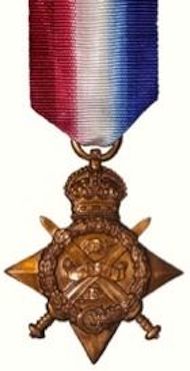
The 1914 Star was the rarest campaign medal and was awarded to around 378, 000 military personnel in total. The vast majority of recipients were in the regular army before the war or special reservists. The Star was authorised by King George V in April 1917 for those who had served in France or Belgium from 5th August 1914 to midnight on 22nd November 1914. The first sixteen weeks of the war saw intense combat in August swiftly followed by the retreat from Mons, the battles of the Marne, Aisne, Armentières, Yser and the first battle of Ypres.
The award of the bronze medal was open to officers and men of the British and Indian Expeditionary Forces and doctors, nurses, and sailors from the Royal Navy, Royal Marines, Royal Navy Reserve and Royal Naval Volunteer Reserve who served ashore with the Royal Naval Division in France or Belgium. Just under half of the recipients also received a clasp which showed that they had served under enemy fire. The Clasp was a narrow horizontal bronze bar sewn onto the red, white and blue ribbon inscribed with the dates ‘5th AUG.–22nd NOV.1914′. A small silver heraldic rose could be attached to the ribbon when just the ribbon was being worn. The reverse of the bronze medal is impressed with the recipient’s service number, rank, name and unit. The 1914 Star was always awarded with the British War and Victory medals.
Radcliffe servicemen and the 1914 Star
Thirty-four Radcliffe on Trent men who were entitled to the 1914 Star have been identified from Medal Roll Index Cards. Twenty seven of them have been confirmed as regular army servicemen and two confirmed in the navy. One volunteered in August 1914. It is likely that the remaining four were either already in the army by August 1914 or reservists but records confirming their military status in 1914 have not yet been found. Nine of these thirty-four men were killed in action and three died of illnesses either during or immediately after the war. Ten are known to have been wounded, including one who was later killed. Three were prisoners of war, including one of the wounded men. One was hospitalised with a heart condition. Only eight of the men who were fighting from 1914 onwards, including the two in the navy, survived relatively unscathed as far as we know. Those men awarded the 1914 Star are as follows:
Regular army and reservists
Bell, Henry
Bemrose, Bertie (killed in action, 29.5.1918)
Bemrose, Ernest (killed in action, 20.10.1914)
Bemrose, Percy (killed in action, 12.3.1915)
Bemrose, William (wounded, transferred to the reserves November 1917)
Berridge, Gordon (died of TB, 14.12.1915)
Blew-Jones, Douglas (heart condition while on active service)
Cherry, Charles (wounded, 11.3.15. 17.6.18 returned to front)
Doughty, Fred
Draper, Percy (killed in action, 22.2.1915)
Foster, Robert
Flower, Harold
Flower, Thomas (wounded 22.5.15, wounded again Nov. 1917, discharged)
Haines, Sam (wounded 27.10.14, transferred to reserves UK)
Hallam, William
Humphrey, Ernest (died of illness, 5.2.1920)
Madeley, Wilfred (wounded twice, September 1915 and September 1916)
Marshall, Henry (chaplain to the forces on the western front)
Mason, John Henry (wounded twice, 26.11.14 and June 2016)
Newham, George (wounded 30.12.15, wounded again and taken prisoner of war 21.3.18)
Smith, George
Thorpe, Harry (Prisoner of War for four years from 20.11.14)
Todd, Bertie (killed in action, 9.5.1915)
Tytherley, Charles (killed in action, 10.10.1916)
Voce, Henry (killed in action, 10.9.1914)
Walker, George H. (wounded, later killed in action, 3.8.1917)
Waters, Thomas (wounded 23.9.14, returned France 4.10.15)
Royal Navy
Howard, Arthur
Smith, George Lancelot Vernon (later killed in action, WWII)
Volunteer, enlisted August 1914
Military status in 1914 of the following men has not yet been confirmed by official records. All served in the army.
Beet, Horace (died of illness, 26.12.1918)
Draper,Walter (killed in action, 13.5.1915)
Pepper, John (Prisoner of War 30.11.17)
Stratton, Thomas (wounded 1.10.14)
1914-1915 Star
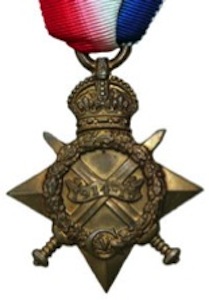
The 1914–1915 Star is similar to the 1914 Star. The medal was established in December 1918 and issued to all who served against Germany in any theatre of war between 5th August 1914 and 31st December 1915, except those eligible for the 1914 Star. Like the 1914 Star, the 1914–15 Star was not awarded alone. The recipient also received the British War Medal and the Victory Medal. The reverse is impressed with the recipient’s service number, rank, name and unit. An estimated 2.4 million of these medals were issued. It was not possible to receive both the 1914 Star and the 1914–1915 Star.
Radcliffe servicemen and the 1914-1915 Star
1914–1915 Stars have been confirmed for eighty Radcliffe on Trent men. Of these, eleven were regular army servicemen and three were in the navy. We may find more Radcliffe men who were eligible for this award as our research continues.
British War Medal 1914–18
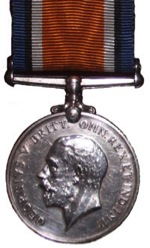
The silver or bronze medal was awarded to all officers and men and women of the British and Imperial Forces who either entered a theatre of war or entered service overseas between 5th August 1914 and 11th November 1918. The medal was established on July 26th 1919. It was possible to be awarded the British War medal without the Victory medal if the recipient served overseas but not in a theatre of war. Men serving in garrisons in India, for instance, would fall into this category.
Approximately 6.5 million British War Medals were issued. Most were made of silver; around 10,000 bronze versions were issued mainly to Chinese, Maltese and Indian Labour Corps. The front of the medal depicts the head of George V. The recipient’s service number, rank, name and unit is impressed on the rim.
See description of the Allied Victory medal for Radcliffe recipients of both the British war and Victory medals.
Allied Victory Medal
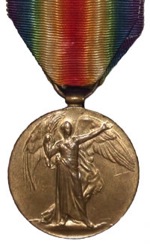
After the war, it was decided that the allies should each issue their own bronze victory medal with a similar design, wording and identical ribbon. The British Victory medal was designed by W. McMillan. The front depicts a winged classical figure representing victory. Approximately 5.7 million victory medals were issued. The recipient’s service number, rank, name and unit is impressed on the rim. It could only be awarded in conjunction with the British War Medal.
Radcliffe servicemen and the British War and Allied Victory medal
To date, 248 Radcliffe men have been identified who were awarded the British War and Victory medals. These men include those who also received the 1914 and 1914–1915 Stars. They are men who served overseas at some point between August 1914 and November 11th 1918. We have established from service records that a further 24 Radcliffe men were entitled to these medals but recorded confirmation has not yet been found for them. We anticipate that the number of men known to be entitled to the medals will increase slightly as our research progresses.
We can confirm that 73% (271) of all the Radcliffe on Trent servicemen were awarded various combinations of the 1914 Star, the 1914–1915 Star, the British War and Victory medals or were entitled to the medals. The remaining 27% of the servicemen either served at home in the U.K, were still in training when the war ended or we have not been able to find their service record and assign them to a military unit.
Gallantry Awards
Gallantry awards were given to individuals for conspicuous or gallant act of valour, usually in the face of the enemy. Awards were also available for distinguished and meritorious service. Names had to be put forward for awards. There would have been countless acts of gallantry during the war which went unnoticed and unrecorded; many men deserving of gallantry awards did not receive them.
Distinguished Conduct Medal
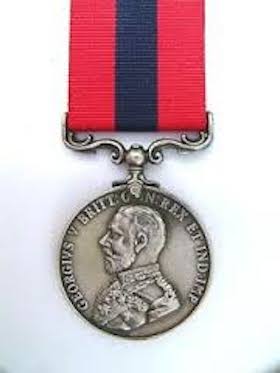
The Distinguished Conduct Medal (D.C.M.) was established on 4th December 1854 during the Crimean war. It was a high level award for gallantry in the field in the face of the enemy, second in prestige only to the Victoria Cross (of which only 615 were awarded in WWI). The DCM was a second level decoration awarded to other ranks (below officers). The reverse side is inscribed “For Distinguished Conduct in the Field”. It was discontinued in 1993 when the DCM, DSO and CGM were replaced by the Conspicuous Gallantry Cross.
Conferment of the DCM was announced in the London Gazette accompanied by a citation. Three DCMs were awarded to Radcliffe on Trent men: Harry Johnson, Edmund Machin and William Williamson.
Sergeant Harry Johnson, 298th Siege Battery Royal Garrison Artillery
Citation:During the period under review he has performed the duties of a No.1 with marked courage and ability. He shows utter disregard of danger, and by his coolness under fire sets an excellent example to his men. Awarded 11.3.1920. Harry Johnson was born in Radcliffe on Trent in 1885 and lived in the village all his life. He died in 1954, age 69.
Battery Sergeant Major Edmund Machin, Royal Horse Artillery
Citation: For conspicuous gallantry and devotion to duty during operations. He has rendered invaluable service throughout and has at all times set a fine example of courage and determination. Awarded 11.5.1917. After the war, Edmund Machin moved from Radcliffe to Retford. He died in 1963, age 82.
Regimental Quarter Master Sergeant William Williamson, Lincolnshire Regiment
Citation: “For conspicuous gallantry and devotion to duty during operations. On one occasion, when the forward ration dump was being heavily shelled, the ration parties were unable to reach the dump owing to the heavy barrage; he remained with the rations at the dump for several hours until it was possible for the parties to reach the dump and carry away the rations. At all times he has carried out his duties in an exemplary manner. Awarded 11.5.1919”
After the war, William Williamson returned to his job as a postman in Langley Mill for the next twenty years. He was in the Home Guard in WWII. He was brought up in Radcliffe on Trent as a child and died in 1982, age 103.
Military Cross
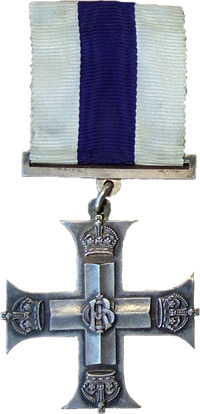
Instituted on 28th December 1914 the Military Cross (M.C.) is a third level military decoration awarded to Officers for an act or acts of exemplary gallantry during active operations against the enemy. Citations for the M.C. were published in the London Gazette during the Great War. The three Radcliffe on Trent servicemen awarded the MC are Norman Dexter, Edward McLandsborough de Warren and William Lisle Rockley.
Lt. Norman Dexter, 17th Bn, The Sherwood Foresters
Citation: “For conspicuous gallantry and devotion to duty. He took command of his company in an attack when his company commander was wounded, and showed great dash and gallantry in overcoming the enemy’s resistance when the advance was held up. By his skilful leadership and fine personal example the position was ultimately captured.” Date awarded 05.04.18. Gazette issue 30614. Gazette page 4211
After the war, Lt. Dexter remained in the army, becoming a Lt. Colonel. He lost and arm as a result of his war service. He lived at Radcliffe Hall, Radcliffe on Trent, for many years.
Lt. Edward Mclandsborough de Warren, Royal Garrison Artillery
Citation: “For conspicuous gallantry and devotion to duty. This officer was acting as liaison officer with the artillery, but in addition to this duty he took a prominent part in guiding and assisting the troops he was with throughout nine hours of shell fire, sharing their risks and inspiring them by his courage and coolness. At the end of the day, when the enemy was approaching, he went out with a gunner to disable the guns which were in front of a strong point, accomplishing this under heavy fire”. Date awarded 13.09.18
After the war, Edward Warren farmed in Argentinia for many years, where he was known as Don Eduardo. He died in 1950, age 52. His son wrote in his biography that he never fully recovered from his war wounds.
Lieutenant William Lisle Rockley, 10th Bn York and Lancaster Regiment
Citation: ‘For conspicuous gallantry and ability in the Gallipoli peninsula. He made two valuable reconnaissances of the enemy’s positions and working parties and sited a work under heavy fire. The latter operation was one of great risk and difficulty and he showed great coolness and determination.’
Date awarded: 21.01.1916
William Rockley was killed by an exploding shell on October 10th 1917, Vierstraat area, Belgium, during the Third Battle of Ypres. He never lived in Radcliffe on Trent but his father, who was born and brought up in the village, donated Rockley Memorial Park to the people of Radcliffe on Trent in honour of his son and the local men who died as a result of the Great War.
Military Medal
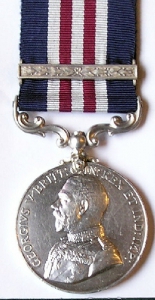
The Military Medal (M.M.) was instituted on 25th March 1916 and is a third level gallantry award for other ranks – their equivalent to the Military Cross for officers. It was awarded for acts of gallantry and devotion to duty under fire to the following servicemen from Radcliffe on Trent.
Corporal Joe Gore, 10th Battalion, The Sherwood Foresters
Sergeant Wilfred Madeley, 2nd Battalion, Kings Royal Rifles
Private Henry Tyler, York and Lancaster Regiment
The citation in the London Gazette for the M.M. does not describe the individual actions that led to the award.
Before the war, Wilfred Madeley was in the regular army serving in India. He then became an asylum attendant at the Nottingham County Asylum (Saxondale). Henry Tyler was also an attendant there but with no previous service experience. Joe Gore worked in the local fish shop.
Mentioned in Despatches

Mentioned in Despatches is a commendation for an act of gallantry or service. The phrase ‘mentioned in despatches’ was coined by Winston Churchill in 1898 and the award has been published in the London Gazette from the time of the Boer War. During the war, those awarded M.I.Ds received a certificate. In 1920 an oak leaf emblem was issued to be pinned or sewn diagonally on to the ‘Victory’ medal ribbon. In order to qualify, a serviceman’s gallant or meritorious act in the face of an enemy would be recorded in the official report written by a superior officer and sent to the high command. The despatch was published in the London Gazette.
Seven Radcliffe men were mentioned in despatches, three of whom received other gallantry awards:
Lt. Colonel Charles Wilfred Birkin, C.M.G., 1st/7th Battalion, The Sherwood Foresters was mentioned once.
2nd Lt William Brewster Haynes, Royal Field Artillery, was mentioned once
BSM Edmund Machin D.C.M., Royal Horse Artillery, was mentioned once
Major Henry Marshall, M.C. Chaplain to the Armed Forces, was mentioned twice
Lt. William Ritter, The Sherwood Foresters Cyclist Corps (later RFC) was mentioned once.
Major Edward Selby (later Lt. Colonel), Royal Army Medical Corps was mentioned three times. He was later awarded an O.B.E. for his war service as a doctor.
RQMS William Williamson D.C.M., Lincolnshire Regiment, was mentioned once.
A Radcliffe man, Charles Frederick Paine, serving with the 24th Australian Infantry Battalion, was recommended for a mention in despatches. His recommendation reads:
“For five days at Pozières, these (five) soldiers distinguished themselves for most gallant devotion to duty as volunteer stretcher bearers carrying the wounded through heavy artillery fire. The conduct of these soldiers has been a valuable object lesson to those who might otherwise have held the terrain too dangerous and intense to cross.”
Date of recommendation: August 9th 1916, five days after Charles Paine was killed at Pozières, the Somme. Recommended by Brigadier-General John Gellibrand, Commander of the 6th Brigade, 2nd Division, Australian Imperial Force.
Service Awards
Meritorious Service Medal
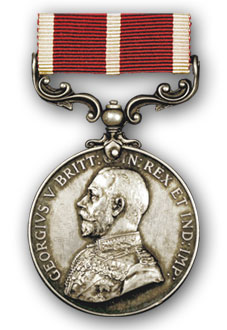
The Meritorious Service Medal was awarded for long and meritorious service. The award was extended from 1916-1919 to include recognition of valuable service rendered with the armies in France and Flanders. Names of recipients were published in the London Gazette.
The medal was awarded to three Radcliffe servicemen:
Colour Sergeant Joseph Berry, 24th Bn, Manchester Regiment
Colour Sergeant Quarter Master Claude Clarke, Royal Engineers
Bombardier Charles Vickerstaff, Royal Field Artillery
After the war, Joseph Berry moved into one of the first council houses in Radcliffe on Trent. Claude Clark moved at some point to Sutton Coldfield. Charles Vickerstaff, whose three brothers also served in the war and survived, moved to Surrey in the early 1920s.
American Red Cross Service Medal
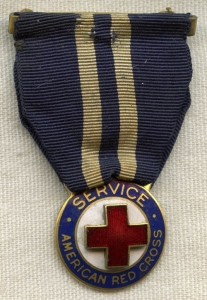
The British Red Cross War Medal, instituted in 1920, was awarded to those who served in the U.K. from August 1914–December 1919 and had undertaken at least 1000 hours of voluntary service. Ambulance drivers and stretcher bearers who had undertaken at least 500 hours of service were also eligible. Claire Birkin, an American woman born in New York, was awarded the American Red Cross Service Medal for her work with the Red Cross in Nottinghamshire. She was a district secretary of the British Red Cross, Commandant of the 94th Voluntary Aid Detachment and Commandant of Lamcote Auxiliary Hospital for Officers. She was chair of the American Red Cross Society in Nottingham.
Orders of Chivalry
Companion of Most Distinguished Order of St Michael & St George
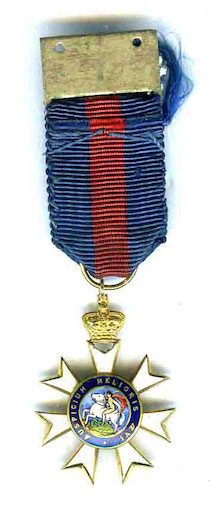
The C.M.G. is a British order of chivalry founded in 1818 in honour of two military saints, St Michael and St George. Originally awarded to those holding high offices in the British Empire, it was extended to include those of high office who render important non-military service in relation to foreign and Commonwealth affairs.
The Order was awarded to one Radcliffe serviceman: Lt/Colonel Charles Wilfred Birkin for ‘services rendered in connection with Military Operations in the Field, to be dated from 1st January, 1916’.
The Most Excellent Order of the British Empire
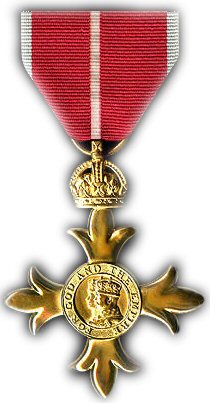
The O.B.E. was established by George V in 1917 for a range of useful services. Its original intention was to honour the non-combatant service of thousands of people during the First World War.
There is one Radcliffe recipient, Edward Selby. As a young doctor, he served in the Royal Army Medical Corps on the Western Front, becoming a deputy assistant director of medical services. He was mentioned in despatches three times.
Grand Priory of the Order of the Hospital of St. John of Jerusalem in England.
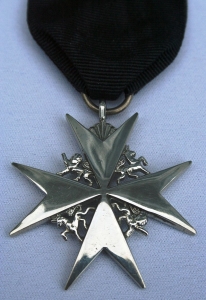
The Grand Priory of the Order of the Hospital of St. John of Jerusalem in England is a royal order of chivalry constituted by Queen Victoria in 1888. It is associated with the St. John Ophthalmic Hospital, Jerusalem and the St. John Ambulance Brigade. The order is conferred on those chosen for their work in preventing and relieving sickness or injury and enhancing the health and well being of people anywhere in the world. There are two Radcliffe on Trent recipients:
On July 31st 1924 Claire Birkin received a royal order of chivalry on her investiture as a Lady of Grace of the Grand Priory of the Order of the Hospital of St. John of Jerusalem in England. She received the members badge of an eight-pointed Maltese Cross alternating with two lions passant guardant and two unicorns passant.
On June 28th 1953 Lieutenant Colonel Edward James Selby, O.B.E., M.R.C.S., L.R.C.P. was awarded the Venerable Order of the Hospital of St. John of Jerusalem. Edward Selby remained as a military doctor after WWI. He lived in London.
Civilian Medals: France and Belgium
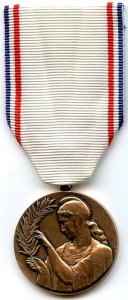
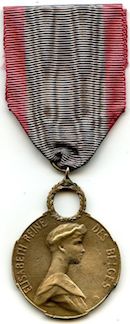
The Médaille de la Reconnaissance Française was a French medal awarded only to civilians. It was established on 13th July 1917. The medal was an acknowledgement by the French government of those who had aided the injured, disabled or refugees, particularly in a voluntary capacity, or had performed an act of exceptional dedication in the presence of the enemy. It was conferred on both French citizens and foreigners including those who supported the French war effort through fund raising and the provision of aid. It was last awarded in 1959.
Claire Birkin from Radcliffe on Trent, whose work included raising money for the French Red Cross, was one of around 15,000 recipients.
The Médaille de la Reine Élisabeth (1914–1918) is a Belgian medal created by royal decree on 15th September 1915. It was an acknowledgement for those who had cared for suffering victims of war for at least a year before 10th September 1919. Recipients who earned the medal by working in hospitals received a variant with a red enamelled cross in the suspension wreath.
Claire Birkin from Radcliffe on Trent was awarded the medal for her services to the people of Belgium.
Silver War Badge
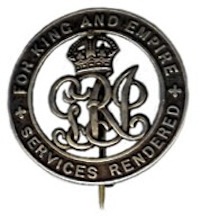
The Silver War Badge, instituted on 12th September 1916, was originally issued to officers and men who were discharged or retired from the military forces as a result of sickness or injury caused by their war service. After April 1918 eligibility was extended to include civilians serving with the Royal Army Medical Corps, female nurses, staff and aid workers. It was not necessary to serve overseas to receive the badge.
The inscription “For King and Empire; Services Rendered” round the rim meant it was often known as the “Services Rendered Badge”. Each badge was engraved with a unique number on the reverse. The recipient would also receive a certificate with the badge. It was made of sterling silver and was intended to be worn on the right breast of a recipient’s civilian clothing. It could not be worn on a military uniform.
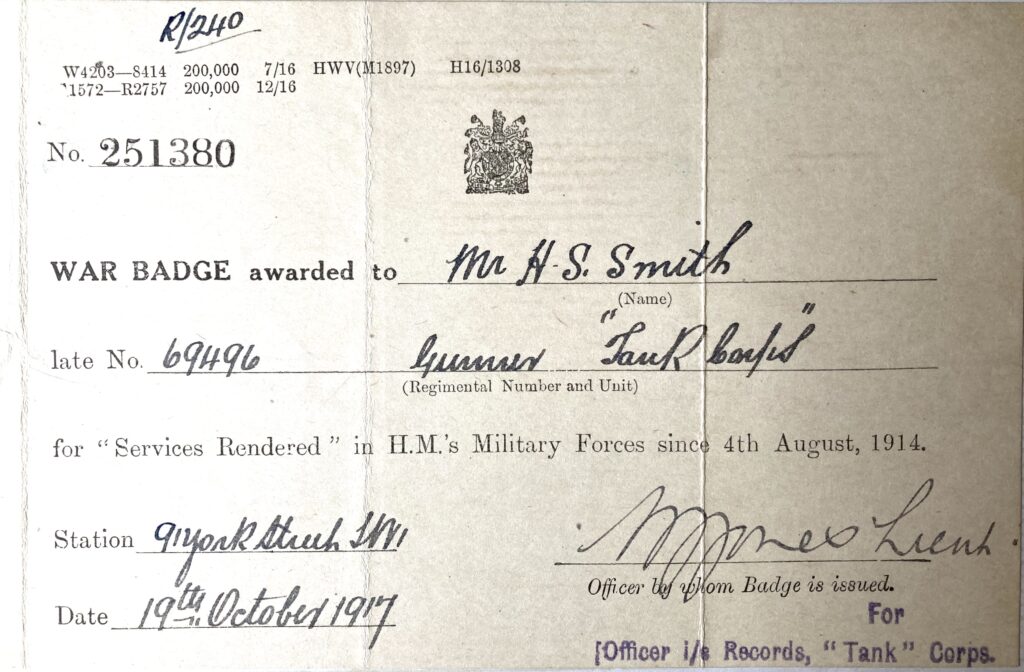
Certificate received with Silver War Badge
There were approximately 1,150,000 Silver War Badges issued in total for First World War service. Many who were eligible did not apply. To date, Silver War Badges have been confirmed for 34 Radcliffe on Trent men. This figure does not reflect the great number of Radcliffe servicemen who were wounded during the war.
Radcliffe on Trent recipients of Silver War Badges (Stars and Gallantry Awards also noted)
Names of those who died shortly after the war as a result of their illness or injuries are in red. Unless otherwise indicated below, those listed had a life span corresponding to the average mortality rate of the time.
Barry, John (shell wound to foot)
Bates, John Dennis (contracted illness in munitions factory)
Bee, William (gunshot wounds to chest)
Bellaby, Edgar (injuries or illness unknown)
Buxton, Charles (injuries or illness unknown)
Cook, Charles (trench fever affecting throat)
Clarke, Claude Henry MSM (sickness)
Cresswell, Harold Checkley (fracture)
Davies, H (gun shot wound to head)
Duke, Francis Hitchcock (malaria)
Eason, James (injuries or illness unknown)
Flower, Thomas (wounded in the arm, killed in accident 1936)
Giles, Percy Thomas (injuries or illness unknown)
Gore, Charles (heart disease)
Hall, John Henry (injuries or illness unknown)
Handford, William (injuries or illness unknown – served in UK)
Haynes, Samuel (Sickness)
Holmes, Frank (Pulmonary Tuberculosis)
Hoppe, Edward (awarded after operation on stomach, died 1918)
Howard, Constance Lizzie (unknown, possibly pyonephrosos)
Hyde, Leslie Toyne (carcinoma)
Leese, Charles (injuries or illness unknown – served in UK, died 1930)
Leeson, George (injuries or illness unknown)
Longley, Walter (tuberculosis)
Madeley, Wilfred MM, 1914 Star (wounded)
Malson, Reginald Harry (gun shot wound arm)
Newham, George (shell wound foot, later gunshot wound thigh)
Parker, Samuel (osteoarthritis)
Richardson, Walter (Tuberculosis)
Richmond, Harry (injuries or illness unknown, died 1932)
Richmond, Leonard (eyesight problems)
Rushmore, Leonard (gas, shell shock, died 1919)
Searle, Frank (gunshot wounds neck and shoulders)
Smith, Herbert Sudbury (heart problems)
Spencer, Fred (wounded)
Stanley, Arthur (shell wound, damage to ears)
Taylor, Wilfred Jackson (illness, trench fever, TB, died 1921)
Toon, George Francis (damage to nose and face)
Turner, Lawrence (gunshot wounds to leg and foot, died 1923)
Vickerstaff, William (gunshot wound and amputation)
Wesson, Horace (injuries or illness unknown)
Walter Wilson (gas)
